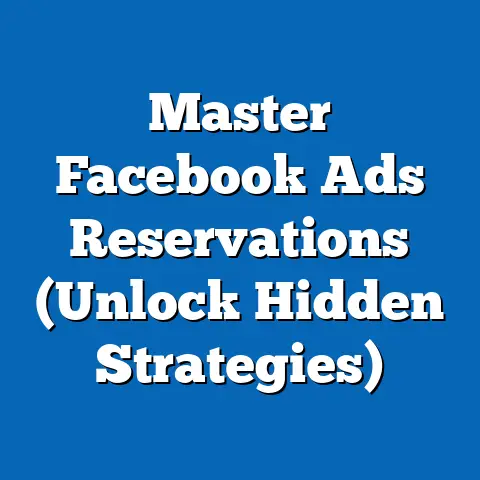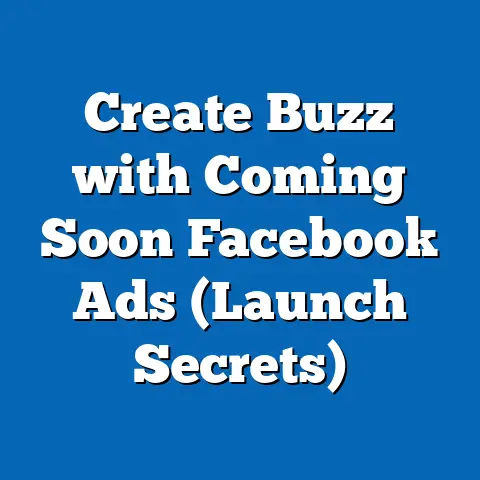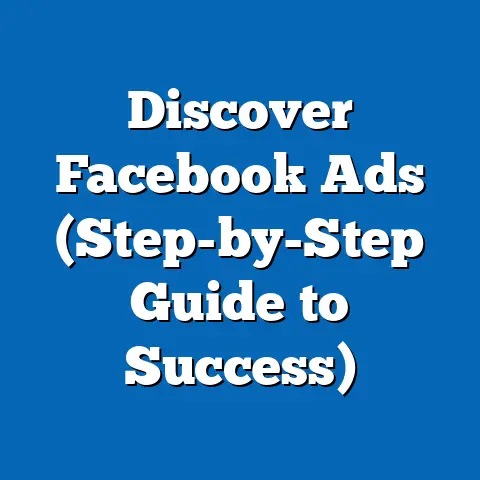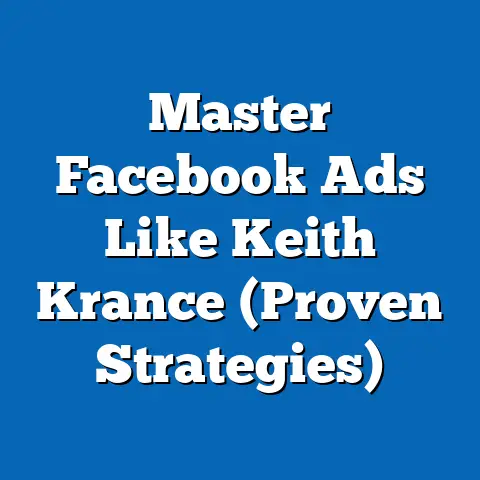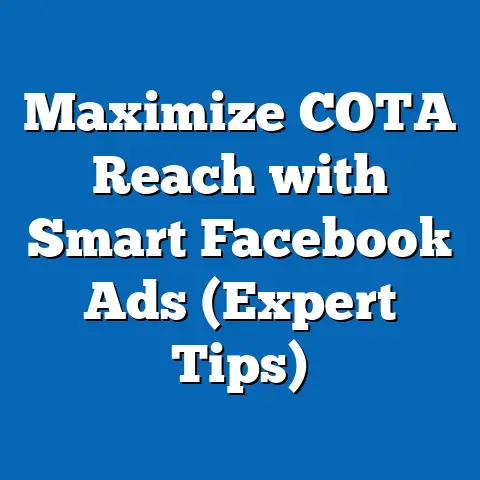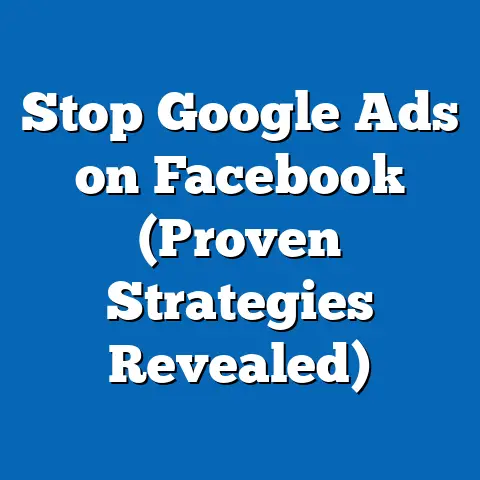Boost Engagement with Facebook Sponsored Ads (Expert Secrets)
The digital advertising landscape is in constant flux, a swirling vortex of algorithms, trends, and ever-evolving consumer behaviors. Amidst this chaos, Facebook, now Meta, remains a dominant force, a vital platform for brands and businesses seeking to connect with their target audiences. It’s not enough to simply be on Facebook; you need to be engaging.
Engagement, in the digital realm, is the lifeblood of success. It’s the currency of attention, the measure of resonance, and the key to building lasting relationships with customers. Engagement metrics – likes, comments, shares, saves, and clicks – are not just vanity metrics; they are crucial indicators of how well your advertising campaigns are performing and whether your message is truly connecting with your audience.
I’ve witnessed firsthand the power of engagement in driving tangible results. I remember working with a local bakery struggling to gain traction online. Their organic reach was limited, and their posts were largely ignored. By strategically leveraging Facebook Sponsored Ads and focusing on creating highly engaging content (think mouthwatering photos of freshly baked goods and behind-the-scenes glimpses into their kitchen), we were able to dramatically increase their reach, engagement, and ultimately, their sales.
The shift towards personalized and targeted advertising is undeniable. Consumers are bombarded with ads every day, and they’ve become adept at filtering out the noise. To break through, you need to deliver messages that are relevant, compelling, and tailored to their specific interests and needs. This is where Facebook Sponsored Ads come into their own.
This article is your roadmap to unlocking the expert secrets for boosting engagement with Facebook Sponsored Ads. I’ll guide you through the intricacies of the platform, share proven strategies, and equip you with the knowledge you need to create campaigns that not only reach your target audience but also resonate with them on a deeper level, fostering meaningful connections and driving real business results. Let’s dive in!
Section 1: Understanding Facebook Sponsored Ads
Facebook Sponsored Ads are the paid advertisements you see on the platform, strategically placed within users’ feeds, stories, and other areas of the site. They are designed to reach a wider audience than organic posts and are targeted based on various demographic, interest, and behavioral factors.
Sponsored Ads vs. Organic Posts: What’s the Difference?
The fundamental difference lies in reach and control. Organic posts are visible to your existing followers and potentially their friends, relying on the algorithm to determine visibility. Sponsored Ads, on the other hand, allow you to actively target specific audiences beyond your follower base, significantly expanding your reach and influence. You have complete control over who sees your ad, when it’s displayed, and how much you spend.
Exploring the Diverse Landscape of Facebook Ad Formats
Facebook offers a rich tapestry of ad formats, each with its own unique strengths and tailored to different objectives. Understanding these formats is crucial for crafting effective campaigns. Here’s a rundown of some of the most popular options:
-
Image Ads: The simplest and most versatile format, image ads feature a single image with accompanying text. They’re perfect for showcasing products, promoting events, or conveying a simple message.
-
Video Ads: Video ads are incredibly engaging and can be used to tell stories, demonstrate product features, or capture attention with dynamic visuals. They are highly effective for driving brand awareness and generating leads. I’ve found that shorter, punchier videos (under 15 seconds) often perform best, especially on mobile.
-
Carousel Ads: Carousel ads allow you to showcase multiple images or videos in a single ad unit, each with its own headline, description, and link. They’re ideal for showcasing a range of products, highlighting different aspects of a service, or telling a story sequentially.
-
Collection Ads: Designed for e-commerce businesses, collection ads feature a catalog of products that users can browse directly within the ad. They provide a seamless shopping experience and are highly effective for driving sales.
-
Instant Experience Ads (formerly Canvas Ads): These immersive, full-screen ads provide a rich and interactive experience for users. They’re perfect for showcasing products in detail, telling compelling stories, and creating a memorable brand experience.
-
Lead Ads: Lead ads are designed to generate leads directly within the Facebook platform. They feature a simple form that users can fill out with their contact information, making it easy to capture leads without sending them to a landing page.
-
Slideshow Ads: Slideshow ads are a cost-effective alternative to video ads, using a series of still images to create a dynamic visual experience. They’re perfect for showcasing products, telling stories, or conveying a message in a visually engaging way.
Image Ads: The simplest and most versatile format, image ads feature a single image with accompanying text. They’re perfect for showcasing products, promoting events, or conveying a simple message.
Video Ads: Video ads are incredibly engaging and can be used to tell stories, demonstrate product features, or capture attention with dynamic visuals. They are highly effective for driving brand awareness and generating leads. I’ve found that shorter, punchier videos (under 15 seconds) often perform best, especially on mobile.
Carousel Ads: Carousel ads allow you to showcase multiple images or videos in a single ad unit, each with its own headline, description, and link. They’re ideal for showcasing a range of products, highlighting different aspects of a service, or telling a story sequentially.
Collection Ads: Designed for e-commerce businesses, collection ads feature a catalog of products that users can browse directly within the ad. They provide a seamless shopping experience and are highly effective for driving sales.
Instant Experience Ads (formerly Canvas Ads): These immersive, full-screen ads provide a rich and interactive experience for users. They’re perfect for showcasing products in detail, telling compelling stories, and creating a memorable brand experience.
Lead Ads: Lead ads are designed to generate leads directly within the Facebook platform. They feature a simple form that users can fill out with their contact information, making it easy to capture leads without sending them to a landing page.
Slideshow Ads: Slideshow ads are a cost-effective alternative to video ads, using a series of still images to create a dynamic visual experience. They’re perfect for showcasing products, telling stories, or conveying a message in a visually engaging way.
Unveiling the Secrets of the Facebook Ad Algorithm
The Facebook ad algorithm is the invisible force that determines which ads are shown to which users. It’s a complex and constantly evolving system that takes into account a multitude of factors, including:
- Bid: The amount you’re willing to pay for each click or impression.
- Relevance Score: A measure of how relevant your ad is to the target audience.
- Estimated Action Rate: The likelihood that a user will take the desired action (e.g., click, like, comment).
- Ad Quality: The overall quality of your ad, including its visual appeal and clarity of messaging.
The algorithm prioritizes ads that are relevant, engaging, and of high quality, rewarding advertisers who create compelling content that resonates with their target audience.
I learned this lesson the hard way early in my career. I was running a campaign for a client selling fitness equipment, and while my targeting was accurate, my ads were bland and uninspired. My relevance scores were low, and my ads were barely being shown. By investing in higher-quality visuals and crafting more engaging ad copy that highlighted the benefits of their products, I was able to dramatically improve my relevance scores and see a significant increase in ad delivery and engagement.
Facebook Ad Effectiveness: The Numbers Don’t Lie
Statistics paint a clear picture of the power of Facebook Sponsored Ads. According to recent data:
- Facebook reaches over 2.9 billion monthly active users, offering unparalleled reach for advertisers.
- The average click-through rate (CTR) for Facebook ads is around 0.9%, significantly higher than many other advertising platforms.
- Facebook ads can generate a return on ad spend (ROAS) of up to 5x, making them a highly cost-effective advertising option.
These numbers underscore the potential of Facebook Sponsored Ads to drive engagement, generate leads, and ultimately, grow your business.
Key Takeaway: Understanding the different types of Facebook Sponsored Ads, how the algorithm works, and the platform’s overall effectiveness is crucial for laying the foundation for successful campaigns.
Next Steps: Explore the different ad formats within Facebook Ads Manager and consider which ones are most appropriate for your specific goals and target audience. Research case studies and examples of successful Facebook ad campaigns to gain inspiration and insights.
Section 2: The Psychology of Engagement
To truly master Facebook Sponsored Ads, you need to understand the underlying psychology of engagement. What motivates users to like, comment, share, and click on your ads? What makes them stop scrolling and pay attention?
Decoding the Drivers of Social Media Engagement
Several key psychological principles drive engagement on social media:
-
Emotional Connection: People are more likely to engage with content that evokes an emotional response, whether it’s joy, sadness, anger, or inspiration. Ads that tell compelling stories, showcase relatable characters, or address pressing social issues can create a strong emotional connection with the audience.
-
Social Proof: People are influenced by the actions of others. When they see that others are liking, commenting, and sharing your content, they’re more likely to do the same. This is why it’s important to encourage social interaction and highlight positive feedback.
-
Reciprocity: People are more likely to engage with content from brands that provide value and offer something in return. This could be a free download, a discount code, or simply helpful and informative content.
-
Scarcity: People are more likely to take action when they believe that something is in limited supply or available for a limited time. Creating a sense of urgency can drive engagement and encourage immediate action.
-
Novelty: People are drawn to things that are new, different, and unexpected. Ads that use creative visuals, unconventional messaging, or innovative formats can capture attention and stand out from the crowd.
Emotional Connection: People are more likely to engage with content that evokes an emotional response, whether it’s joy, sadness, anger, or inspiration. Ads that tell compelling stories, showcase relatable characters, or address pressing social issues can create a strong emotional connection with the audience.
Social Proof: People are influenced by the actions of others. When they see that others are liking, commenting, and sharing your content, they’re more likely to do the same. This is why it’s important to encourage social interaction and highlight positive feedback.
Reciprocity: People are more likely to engage with content from brands that provide value and offer something in return. This could be a free download, a discount code, or simply helpful and informative content.
Scarcity: People are more likely to take action when they believe that something is in limited supply or available for a limited time. Creating a sense of urgency can drive engagement and encourage immediate action.
Novelty: People are drawn to things that are new, different, and unexpected. Ads that use creative visuals, unconventional messaging, or innovative formats can capture attention and stand out from the crowd.
Storytelling: Weaving Narratives that Resonate
Storytelling is a powerful tool for driving engagement on Facebook. People are naturally drawn to stories, and ads that tell compelling narratives can capture attention, build emotional connections, and create a lasting impression.
I’ve seen this work wonders time and again. One of my clients, a small travel agency, was struggling to attract new customers. Instead of simply listing their tour packages, we created a series of video ads that told the stories of past travelers, showcasing their experiences and highlighting the transformative power of travel. These ads resonated deeply with the audience, generating a surge in engagement and bookings.
Visual Appeal: Capturing Attention in a Scroll-Driven World
In the fast-paced world of social media, visuals are king. Your ads need to be visually appealing and eye-catching to capture attention and stand out from the noise. High-quality images, vibrant colors, and compelling video footage can all contribute to a visually engaging ad.
Learning from Success: Analyzing Engaging Facebook Ad Campaigns
Let’s examine some examples of successful Facebook ad campaigns that effectively tapped into psychological principles to boost engagement:
-
Dove’s “Real Beauty” Campaign: This campaign challenged conventional beauty standards and celebrated the diversity of women’s bodies. It resonated deeply with the audience, generating a massive amount of engagement and sparking a global conversation about beauty and self-acceptance. This campaign tapped into the emotional connection and social proof principles.
-
Airbnb’s “Live There” Campaign: This campaign encouraged travelers to experience cities like locals, showcasing unique neighborhoods and hidden gems. It appealed to the desire for authentic experiences and created a sense of community. This campaign leveraged the storytelling and novelty principles.
-
Dollar Shave Club’s Launch Video: This humorous and irreverent video went viral, introducing the brand to a massive audience and generating a surge in subscriptions. It used humor and novelty to capture attention and create a memorable brand experience. This campaign utilized the novelty and emotional connection (humor) principles.
Dove’s “Real Beauty” Campaign: This campaign challenged conventional beauty standards and celebrated the diversity of women’s bodies. It resonated deeply with the audience, generating a massive amount of engagement and sparking a global conversation about beauty and self-acceptance. This campaign tapped into the emotional connection and social proof principles.
Airbnb’s “Live There” Campaign: This campaign encouraged travelers to experience cities like locals, showcasing unique neighborhoods and hidden gems. It appealed to the desire for authentic experiences and created a sense of community. This campaign leveraged the storytelling and novelty principles.
Dollar Shave Club’s Launch Video: This humorous and irreverent video went viral, introducing the brand to a massive audience and generating a surge in subscriptions. It used humor and novelty to capture attention and create a memorable brand experience. This campaign utilized the novelty and emotional connection (humor) principles.
Expert Insights: Words of Wisdom from Digital Marketing Leaders
“People don’t buy what you do; they buy why you do it.” – Simon Sinek
This quote highlights the importance of connecting with your audience on an emotional level and communicating your values and purpose.
“Content is fire; social media is gasoline.” – Jay Baer
This quote emphasizes the importance of creating high-quality content that is worth sharing and engaging with.
“Marketing is no longer about the stuff that you make, but about the stories you tell.” – Seth Godin
This quote underscores the power of storytelling in modern marketing.
Key Takeaway: Understanding the psychology of engagement is crucial for crafting Facebook Sponsored Ads that resonate with your target audience and drive meaningful results.
Next Steps: Consider the emotional triggers that are relevant to your target audience and how you can incorporate them into your ad messaging and visuals. Experiment with different storytelling techniques and visual formats to see what resonates best with your audience.
Section 3: Targeting the Right Audience
Reaching the right audience is paramount for maximizing engagement with your Facebook Sponsored Ads. Showing your ads to people who are genuinely interested in your products or services will drastically increase the likelihood of them interacting with your content.
The Power of Precision: Why Audience Targeting Matters
Think of it this way: You wouldn’t try to sell snow shovels in the desert, would you? Similarly, showing your ads to the wrong audience is a waste of time and money. Audience targeting allows you to focus your advertising efforts on the people who are most likely to be interested in what you have to offer, increasing your engagement rates and driving better results.
Facebook’s Targeting Arsenal: A Comprehensive Overview
Facebook offers a wide range of targeting options, allowing you to reach specific audiences based on various demographic, interest, and behavioral factors. Here’s a breakdown of some of the most important options:
-
Demographic Targeting: Target users based on age, gender, location, education, relationship status, and other demographic characteristics.
-
Interest Targeting: Target users based on their interests, hobbies, and passions. You can target people who are interested in specific topics, brands, or activities.
-
Behavior Targeting: Target users based on their online behavior, such as their purchase history, website visits, and app usage.
-
Custom Audiences: Create custom audiences based on your existing customer data, such as email lists, website visitors, or app users. This allows you to retarget people who have already interacted with your brand.
-
Lookalike Audiences: Create lookalike audiences based on your existing customer data. Facebook will identify users who share similar characteristics with your best customers, allowing you to reach new audiences who are likely to be interested in your products or services.
Demographic Targeting: Target users based on age, gender, location, education, relationship status, and other demographic characteristics.
Interest Targeting: Target users based on their interests, hobbies, and passions. You can target people who are interested in specific topics, brands, or activities.
Behavior Targeting: Target users based on their online behavior, such as their purchase history, website visits, and app usage.
Custom Audiences: Create custom audiences based on your existing customer data, such as email lists, website visitors, or app users. This allows you to retarget people who have already interacted with your brand.
Lookalike Audiences: Create lookalike audiences based on your existing customer data. Facebook will identify users who share similar characteristics with your best customers, allowing you to reach new audiences who are likely to be interested in your products or services.
A Step-by-Step Guide to Defining Your Target Audience
Defining your target audience is a critical first step in creating a successful Facebook ad campaign. Here’s a step-by-step guide to help you get started:
- Identify Your Ideal Customer: Who are they? What are their demographics? What are their interests? What are their pain points?
- Research Your Audience: Use Facebook Audience Insights to learn more about your target audience. This tool provides valuable data about their demographics, interests, and behaviors.
- Create Audience Personas: Develop detailed profiles of your ideal customers, including their demographics, interests, behaviors, and motivations.
- Test Different Targeting Options: Experiment with different targeting options within Facebook Ads Manager to see what works best for your campaign.
- Refine Your Targeting: Continuously monitor your campaign performance and refine your targeting based on the data you collect.
I’ve learned the importance of defining your audience the hard way. In one instance, I was running a campaign for a client selling organic baby food. Initially, I targeted all parents with young children. However, I quickly realized that this was too broad of an audience. By refining my targeting to focus on parents who were interested in organic food, healthy living, and eco-friendly products, I was able to significantly increase my engagement rates and drive more sales.
Advanced Targeting Strategies: Going Beyond the Basics
Once you’ve mastered the basics of audience targeting, you can explore more advanced strategies to further refine your audience segments and improve engagement rates. Here are a few examples:
-
Layered Targeting: Combine multiple targeting options to create highly specific audience segments. For example, you could target parents who are interested in organic food and who have recently purchased baby products online.
-
Exclusion Targeting: Exclude certain audiences from your targeting to avoid showing your ads to people who are not likely to be interested. For example, you could exclude people who have already purchased your product or who are not located in your target market.
-
Retargeting with Dynamic Product Ads: Retarget website visitors who have viewed specific products on your website with dynamic product ads. These ads showcase the products that the user has viewed, reminding them of their interest and encouraging them to make a purchase.
Layered Targeting: Combine multiple targeting options to create highly specific audience segments. For example, you could target parents who are interested in organic food and who have recently purchased baby products online.
Exclusion Targeting: Exclude certain audiences from your targeting to avoid showing your ads to people who are not likely to be interested. For example, you could exclude people who have already purchased your product or who are not located in your target market.
Retargeting with Dynamic Product Ads: Retarget website visitors who have viewed specific products on your website with dynamic product ads. These ads showcase the products that the user has viewed, reminding them of their interest and encouraging them to make a purchase.
Key Takeaway: Precise audience targeting is essential for maximizing engagement with your Facebook Sponsored Ads. By understanding your target audience and leveraging Facebook’s targeting options, you can ensure that your ads are seen by the people who are most likely to be interested in your products or services.
Next Steps: Use Facebook Audience Insights to research your target audience and create detailed audience personas. Experiment with different targeting options within Facebook Ads Manager to see what works best for your campaign.
Section 4: Crafting Compelling Ad Content
Once you’ve identified your target audience, the next step is to create compelling ad content that captures their attention and drives engagement. Your ads need to be visually appealing, emotionally resonant, and relevant to your audience’s needs and interests.
The Anatomy of an Engaging Facebook Ad
A truly engaging Facebook ad consists of several key components working in harmony:
-
Headline: The headline is the first thing people see, so it needs to be attention-grabbing and relevant to the ad’s content. Use strong verbs, intriguing questions, or compelling offers to pique the reader’s interest.
-
Visual: The visual is the most important element of your ad. Use high-quality images or videos that are visually appealing and relevant to your target audience.
-
Ad Copy: The ad copy should be concise, clear, and persuasive. Highlight the benefits of your product or service and tell a compelling story.
-
Call to Action (CTA): The CTA tells people what you want them to do, such as “Learn More,” “Shop Now,” or “Sign Up.” Use a clear and concise CTA that is relevant to the ad’s content.
Headline: The headline is the first thing people see, so it needs to be attention-grabbing and relevant to the ad’s content. Use strong verbs, intriguing questions, or compelling offers to pique the reader’s interest.
Visual: The visual is the most important element of your ad. Use high-quality images or videos that are visually appealing and relevant to your target audience.
Ad Copy: The ad copy should be concise, clear, and persuasive. Highlight the benefits of your product or service and tell a compelling story.
Call to Action (CTA): The CTA tells people what you want them to do, such as “Learn More,” “Shop Now,” or “Sign Up.” Use a clear and concise CTA that is relevant to the ad’s content.
Expert Insights: Best Practices for Creating Engaging Content
Here are some expert insights on best practices for creating visually appealing and emotionally resonant content that drives engagement:
- Know Your Audience: Understand their needs, interests, and pain points.
- Tell a Story: Connect with your audience on an emotional level.
- Use High-Quality Visuals: Invest in professional photography or videography.
- Keep it Concise: Get to the point quickly and avoid jargon.
- Use a Strong Call to Action: Tell people what you want them to do.
- A/B Test Everything: Experiment with different ad formats, headlines, visuals, and copy to see what works best.
A/B Testing: The Key to Unlocking Optimal Performance
A/B testing is the process of testing two different versions of an ad against each other to see which one performs better. This is a crucial step in optimizing your Facebook ad campaigns and ensuring that you’re using the most effective content.
I’ve found that A/B testing is essential for identifying what resonates with your audience. For example, I was working with a client selling online courses. We ran an A/B test with two different headlines: “Learn a New Skill Today” and “Unlock Your Potential.” The “Unlock Your Potential” headline performed significantly better, generating a higher click-through rate and more conversions.
The Power of User-Generated Content
User-generated content (UGC) is content created by your customers, such as reviews, testimonials, and photos or videos of them using your products. UGC is incredibly powerful for building trust and increasing engagement because it’s seen as more authentic and credible than branded content.
Consider incorporating UGC into your Facebook ad campaigns by featuring customer testimonials, showcasing user-submitted photos, or running contests that encourage users to create content related to your brand.
Key Takeaway: Crafting compelling ad content is essential for capturing attention, driving engagement, and achieving your advertising goals.
Next Steps: Experiment with different ad formats, headlines, visuals, and copy to see what resonates best with your audience. Incorporate UGC into your campaigns to build trust and increase engagement.
Section 5: Leveraging Analytics and Insights
The journey doesn’t end with creating and launching your Facebook Sponsored Ads. In fact, that’s where the real work begins. You need to continuously monitor your campaign performance, analyze the data, and make adjustments to optimize your results.
The Importance of Tracking and Measuring Results
Analytics are the compass that guides your Facebook advertising journey. Without them, you’re sailing blindly, hoping to reach your destination without any real direction. Tracking and measuring your results allows you to see what’s working, what’s not, and where you need to make improvements.
Key Metrics for Evaluating Ad Performance
Several key metrics can help you evaluate the success of your Facebook Sponsored Ads and their impact on engagement:
-
Click-Through Rate (CTR): The percentage of people who click on your ad after seeing it. A high CTR indicates that your ad is relevant and engaging to your target audience.
-
Engagement Rate: The percentage of people who interact with your ad, such as liking, commenting, sharing, or saving it. A high engagement rate indicates that your ad is resonating with your audience and sparking meaningful interactions.
-
Conversion Rate: The percentage of people who take the desired action after clicking on your ad, such as making a purchase, signing up for a newsletter, or filling out a lead form. A high conversion rate indicates that your ad is effectively driving results.
-
Cost Per Click (CPC): The average cost you pay for each click on your ad.
-
Cost Per Conversion (CPC): The average cost you pay for each conversion.
-
Return on Ad Spend (ROAS): The amount of revenue you generate for every dollar you spend on advertising.
Click-Through Rate (CTR): The percentage of people who click on your ad after seeing it. A high CTR indicates that your ad is relevant and engaging to your target audience.
Engagement Rate: The percentage of people who interact with your ad, such as liking, commenting, sharing, or saving it. A high engagement rate indicates that your ad is resonating with your audience and sparking meaningful interactions.
Conversion Rate: The percentage of people who take the desired action after clicking on your ad, such as making a purchase, signing up for a newsletter, or filling out a lead form. A high conversion rate indicates that your ad is effectively driving results.
Cost Per Click (CPC): The average cost you pay for each click on your ad.
Cost Per Conversion (CPC): The average cost you pay for each conversion.
Return on Ad Spend (ROAS): The amount of revenue you generate for every dollar you spend on advertising.
Tools and Software for Tracking Ad Performance
Facebook Ads Manager provides a wealth of data about your ad campaigns, including detailed reports on your key metrics. You can also use third-party analytics tools, such as Google Analytics, to track your website traffic and conversions that result from your Facebook ads.
Expert Recommendations for Optimizing Ad Strategies
Here are some expert recommendations for adjusting your ad strategies based on analytical insights to continually boost engagement:
- Monitor Your Key Metrics Regularly: Keep a close eye on your CTR, engagement rate, conversion rate, and ROAS.
- A/B Test Everything: Experiment with different ad formats, headlines, visuals, and copy to see what works best.
- Refine Your Targeting: Continuously monitor your campaign performance and refine your targeting based on the data you collect.
- Adjust Your Bids: Optimize your bids to ensure that you’re getting the most for your money.
- Pause Underperforming Ads: Don’t be afraid to pause ads that are not performing well.
- Learn from Your Mistakes: Analyze your past campaigns to identify what worked and what didn’t.
Key Takeaway: Leveraging analytics and insights is crucial for optimizing your Facebook Sponsored Ads and continually boosting engagement.
Next Steps: Set up tracking and reporting for your Facebook ad campaigns. Regularly monitor your key metrics and make adjustments to your strategies based on the data you collect.
Conclusion
Throughout this journey, we’ve uncovered expert secrets that empower you to boost engagement with Facebook Sponsored Ads. From understanding the platform’s intricacies and the psychology of engagement to mastering audience targeting and crafting compelling content, you’re now equipped with the knowledge to create campaigns that resonate with your audience and drive real business results.
Remember, the digital advertising landscape is constantly evolving, so it’s crucial to stay ahead of the trends and adapt your strategies to meet evolving consumer expectations. Embrace experimentation, leverage data, and never stop learning.
The future of Facebook advertising is bright, and the potential for businesses to foster deeper connections with their audiences through innovative engagement strategies is immense. By implementing the expert secrets shared in this article, you can unlock the power of Facebook Sponsored Ads and achieve your advertising goals.
So, go forth, create, engage, and watch your business thrive in the dynamic world of Facebook advertising!

